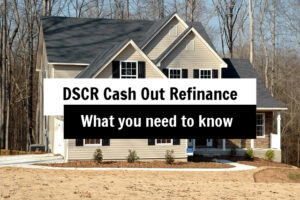Introduction: What Makes DSCR Essential?
Hey there, financial mavens! You’re well-versed in the myriad metrics that guide us through the labyrinth of loan management. Yet, even experts like you can appreciate a fresh take on the debt service coverage ratio (DSCR) loan. This invaluable tool is crucial for both borrowers and lenders, offering a snapshot of your rental property’s financial health.
Calculating DSCR: The Formula Unveiled
Calculating the DSCR is straightforward. You divide your net operating income by your total debt service.
Formula:
DSCR=Net Operating Income divided by Total Debt Service
For instance, if you have a net operating income of $10,000 divided by a total debt service of $8,000, your DSCR would be 1.25.
Interpreting DSCR: What Do the Numbers Mean?
A DSCR greater than 1 indicates that you have sufficient income to meet your debt obligations. In contrast, a DSCR less than 1 signals potential trouble. Here’s how to decode your DSCR:
- Above 1: You’re in the clear.
- Exactly 1: Proceed with caution.
- Below 1: Red flag.
Lenders generally seek a DSCR above 1.15 to 1.35, ensuring a cushion for the borrower.
The Importance for Lenders: Risk Assessment Perfected
For lenders, a high DSCR denotes a low-risk loan. This aligns with their intrinsic need to minimize risk while maximizing returns. Consequently, borrowers with a higher DSCR often enjoy more favorable loan terms.
Why Borrowers Need to Pay Attention
As a borrower, ignoring your DSCR is akin to navigating a maze blindfolded. Monitoring this ratio equips you to proactively manage debts, avoiding the pitfalls of poor financial decisions.
Limitations: The Full Picture
While the DSCR is an invaluable tool, it’s not without limitations. For one, it doesn’t account for variables like market volatility or changes in interest rates. Hence, always consider it alongside other financial metrics.
How to get Approved for a Debt Service Coverage Ratio Loan
DSCR Loan Requirements
- For investment properties only
- Available on purchase and refinance of a property
- Minimum down payment is 20%
- Minimum credit score is 640
- DSCR can be below 1 depending on credit score and loan to value ratio
- First time investors are considered
- Income approval is based on property cash flow, NOT personal income
Key Takeaways: A Quick Recap
- DSCR serves as a reliable metric for evaluating loan affordability.
- A higher DSCR typically translates into more favorable loan terms.
- Both borrowers and lenders benefit from understanding this ratio.
In Conclusion: Your Financial Compass
Your expertise in financial matters sets you apart. Yet, mastering the nuances of DSCR adds another feather to your cap. Think of it as your financial compass, guiding you through the intricate world of loans and investments.
So, next time you find yourself diving into loan agreements, remember to give DSCR the attention it deserves. After all, it could be the linchpin that secures your financial future.
Would you like to dive deeper into other complex financial topics? Let me know! Until then, keep crunching those numbers!
Frequently Asked Questions: DSCR Demystified
Hey again, financial aficionados! You’ve already mastered the core concepts of Debt Service Coverage Ratio (DSCR). But let’s face it, the financial world is brimming with queries that even experts like you might ponder upon. So, here’s a roundup of some frequently asked questions that’ll further sharpen your DSCR acumen.
1. Can DSCR Vary Across Industries?
Absolutely! Industry standards can significantly influence what’s considered a ‘good’ DSCR. For example, a DSCR that’s acceptable in real estate might not fly in the restaurant industry. So, context is key.
2. Does a High DSCR Always Mean a Good Investment?
Not necessarily. A high DSCR indicates lower risk, but it doesn’t capture other elements like growth potential or market conditions. Always weigh in other factors for a rounded view.
3. What Happens if My DSCR is Below 1?
A DSCR below 1 suggests that the property income isn’t sufficient to cover the debt payments. This might make it challenging to secure loans, and it’s a signal for you to revisit your financial strategies.
4. How Can I Improve My DSCR?
Improving your DSCR involves either increasing your income (rent) or decreasing your debts. Consider strategies like improving the property for higher rent or lowering the interest rate by refinancing for lower monthly payments.
5. Do Lenders Look at Other Metrics Alongside DSCR?
Yes, they do. Lenders often examine metrics like the loan-to-value (LTV) ratio, credit score, and real estate market. DSCR is crucial but it’s not the sole deciding factor.
6. Is DSCR the Same as Debt to Income Ratio?
Although they’re similar, they aren’t identical. Debt to Income ratio measures all your monthly obligations against your gross monthly income. DSCR, however, focuses on your property’s ability to service the specific loan in question from your rental income.
7. How Often Should I Check My DSCR?
Ideally, you’d want to monitor your DSCR quarterly. This allows you to keep tabs on your financial health and make timely adjustments to your debt management strategy.
8. Does DSCR Affect My Credit Score?
Indirectly, yes. A low DSCR may make it difficult to meet your debt obligations, which in turn could negatively impact your credit score.
9. Can a Positive DSCR Offset a Poor Credit Score?
A strong DSCR can bolster your loan application, but it’s not a magic wand for poor credit. Lenders consider a range of factors, and a good DSCR can’t completely offset a weak credit score.
10. Is DSCR Relevant for Personal Finance?
While DSCR is more commonly used in business (and real estate investment) finance, its underlying logic can certainly apply to personal finances when assessing your capacity to manage loans and debts.
11. What is a Good Debt Service Coverage Ratio?
Ah, the million-dollar question! Generally, a DSCR above 1 is a good starting point because it means you have more income than debt. However, lenders often look for a DSCR that’s somewhere between 1.15 to 1.35 to offer a cushion. This range essentially provides a safety net, making sure that even if your income fluctuates a bit, you’ll still be able to meet your debt obligations. So, if you’re hitting those numbers, give yourself a pat on the back!
12. Is a DSCR Loan Good?
The term “DSCR loan” isn’t a type of loan per se, but rather a metric used in assessing the feasibility of granting a loan. If you’re asking whether having a loan with a good DSCR is beneficial, then the answer is a resounding yes. A high DSCR shows lenders that you’re a low-risk borrower, which can result in better interest rates and more favorable loan terms. In short, a good DSCR can make your loan experience smoother and potentially less costly.
13. What Does a DSCR of 1.25 Mean?
Let’s break it down. A DSCR of 1.25 means you generate $1.25 for every dollar of debt you have to service. This is generally seen as a positive indicator. In most cases, it’s above the minimum threshold lenders look for, which provides some breathing room. It means you’re not just scraping by; you’ve got a 25% cushion of your income over your debt. While it’s not a sky-high DSCR, it’s often good enough to get favorable loan terms and shows financial stability on your part.

I invite you to reach out.
Get your questions answered.
We are experts on DSCR loans, and close them all across the country. If for some reason we cannot help, we’ll do our very best to point you in the right direction.








What questions do you have?